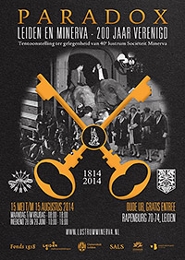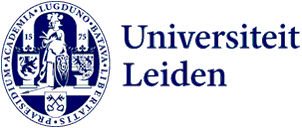Leiden Classics: The paradox of student association Minerva
Minerva, which calls itself the oldest student association of the Netherlands, has the reputation of being an impenetrable bastion. A lustrum exhibition shows the turbulent history and points to a diversity of contacts: from close bonds with Leiden ‘coffee ladies’ to the visit of Sir Winston Churchill.
The oldest in the Netherlands?
In 2014 Minerva celebrated its 200th anniversary,  which made it the oldest student association in the Netherlands. At least, according to Minerva. The association refers to the origins of the Leiden Minerva society which was supposedly established in 1814 above a pub in the Breestraat. The source of this information is the book ‘Student life’ by 19th century law student and renowned writer Johannes Kneppelhout, alias Klikspaan.
which made it the oldest student association in the Netherlands. At least, according to Minerva. The association refers to the origins of the Leiden Minerva society which was supposedly established in 1814 above a pub in the Breestraat. The source of this information is the book ‘Student life’ by 19th century law student and renowned writer Johannes Kneppelhout, alias Klikspaan.
However, the Leiden Student Almanacs up to and including 1935 refer to 1819 as the year the association was founded. Either way, Minerva is indeed by far the oldest student association of Leiden, and with its 1600 members, it is also the second largest (the second oldest Leiden student association, Augustinus, dates from 1893, and it is currently also the largest association, with 1800 members).
Impenetrable bastion
Over the years, the sturdy building on the Breestraat has been home to many members of the royal family (including Princess Beatrix and King Willem-Alexander), future Statesmen, famous writers and of course renowned scientists. The association cherishes its long-standing traditions and the ‘feuten’ (aspirant first-year members) are still submitted to hazing practices. These hazing rituals, in combination with the tightly run association life with its ‘disputes’ and outfits – most students still don a suit and tie (‘jasje-dasje’) or their dispute clothes to go drinking – contribute to the image of an elitist and impenetrable bastion.
Paradox
For the lustrum in 2014, Minerva organisated an exhibition at the former university library (Oude UB) which pointed to an interesting paradox. The general public tends to view Minerva as an impenetrable bastion, says Leiden art historian Jacowies Surie, coordinator of the exhibition and former member of Minerva. ‘We want to show that on the contrary, for the last 200 years, the association has developed very close bonds with the city and the people of Leiden. Minerva members made social contributions over the years, although this often came in waves.’
For instance, The Leiden Student Corps (the precursor of Minerva) breathed in the 19th century new life into Leiden’s 3 October celebrations and members taught workers at the Volkshuis in the early 20th century. Members were also responsible for initiating the student strike in the Second World War, and with the present lustrum, the association is collecting money for the Princess Beatrix Muscle Foundation.
Coffee ladies
The exhibition at the Oude UB also includes photographs and documents on the sometimes very close contacts between Minerva members and ‘regular’ Leiden citizens such as housekeepers and ‘coffee ladies’. Visitors can read letters written by members, including the late Professor of Public Law Ben Telders, to the so-called coffee ladies 'Moeke' Niekenhuis and her daughter Rika. In the early 20th century, these women ran a small shop on the Vrouwenkerkhof where students would gather until deep in the night to drink coffee and eat peanuts. Close bonds were forged and the women received a multitude of thank you notes over the years.
Churchill’s visit
In addition, the exhibition also tells the story of the celebrities who were guests of the oldest student association in the Netherlands. The British former Prime Minister Sir Winston Churchill visited the association on the Breestraat in 1946 after being awarded an honorary degree by Leiden University. He allegedly said ‘I feel tremendous forces in this room’. Visitors to the exhibition can take home a postcard with a photograph of his visit.
Alexander Goblet
The exhibition also includes exceptional collection pieces such as the Alexander Goblet. This silver goblet was donated to the Collegium in 1875 by Prince Alexander of Orange Nassau (the third son of King Willem III), a Leiden student and at the time honorary member of the Lustrum Committee. The goblet is usually only taken out of its safe once a year, for the Dies Natalis Dinner of the association, says Saskia van Otterloo, one of the curators of the exhibition, and a member of Minerva.
Leiden Student Cabaret
In addition to letters, photographs and collection pieces, visitors can also listen to sound bites from the Leiden Student Cabaret of Paul van Vliet, or watch a new film. Fragments of Polygon Journals alternate with recent interviews with former members and Leiden citizens such as neighbourhood policemen, housekeepers of student residences, and neighbours. Van Otterloo: ‘I hope that this exhibition will contribute to reducing some of the prejudices.’
